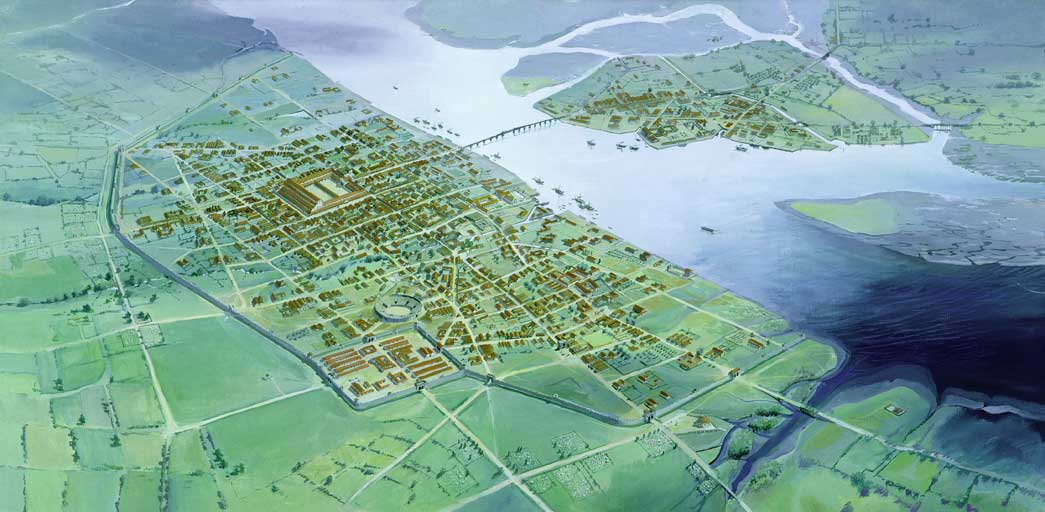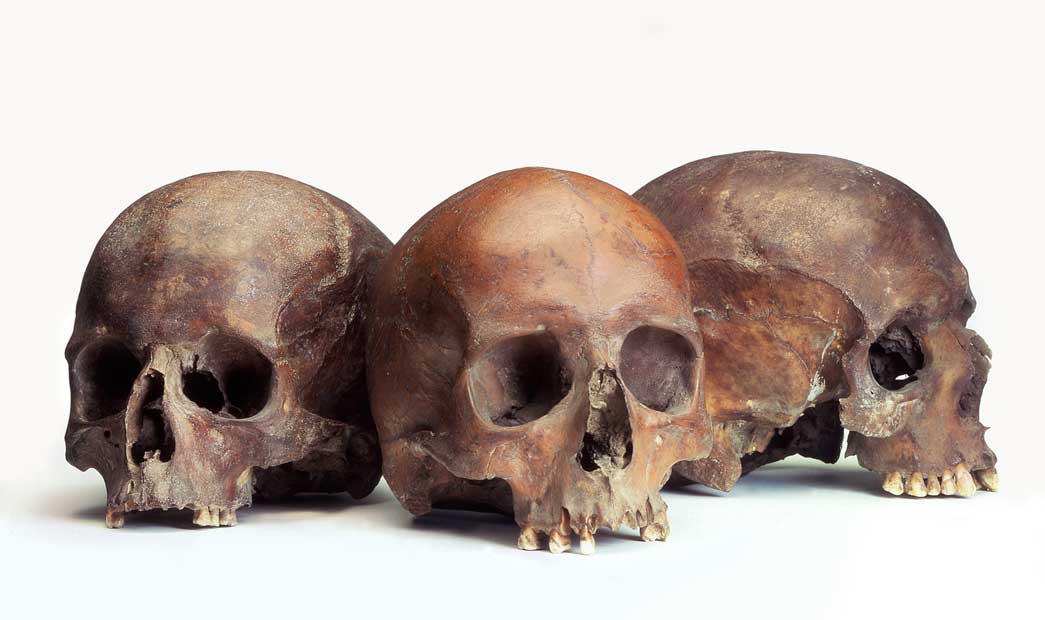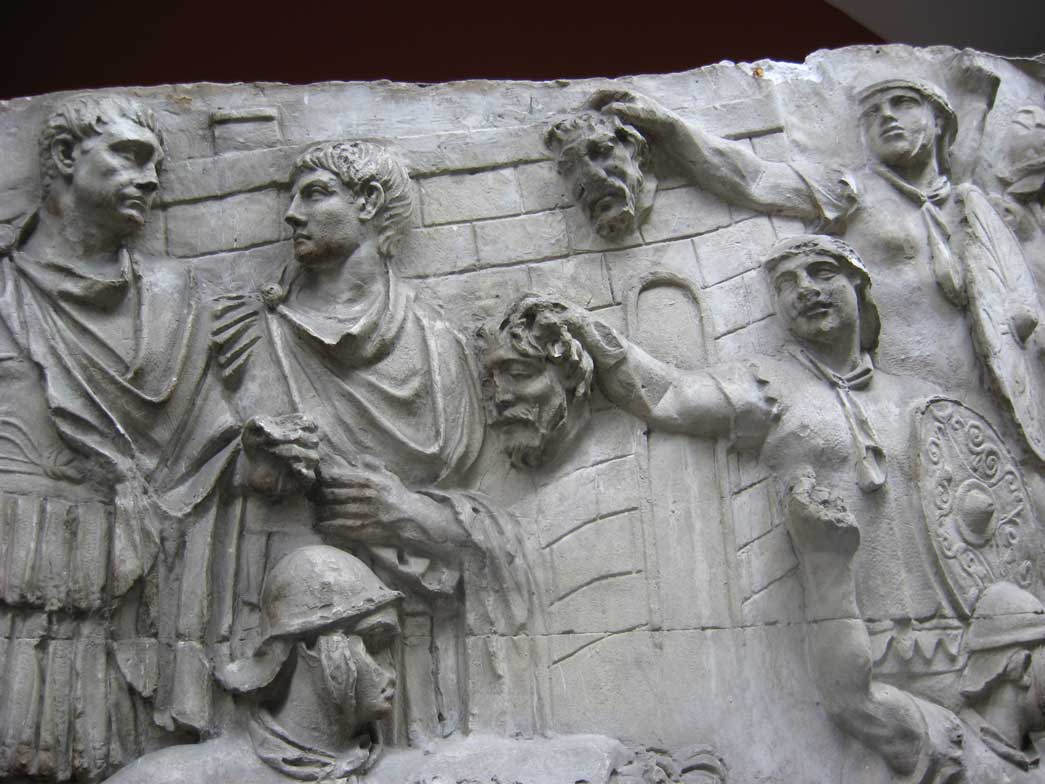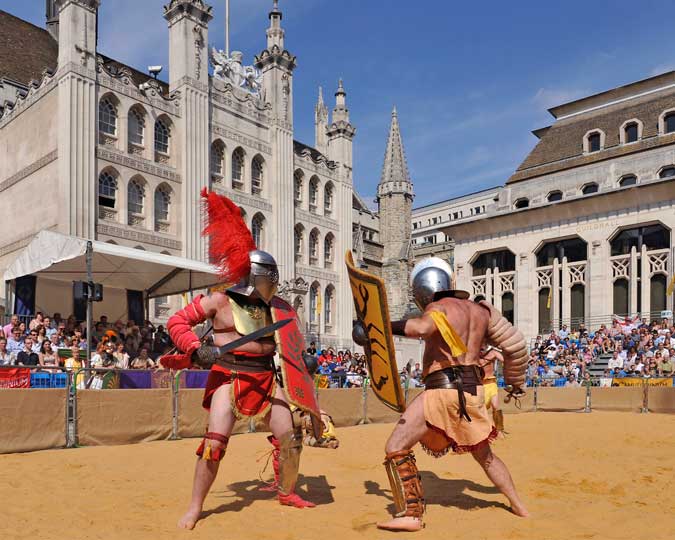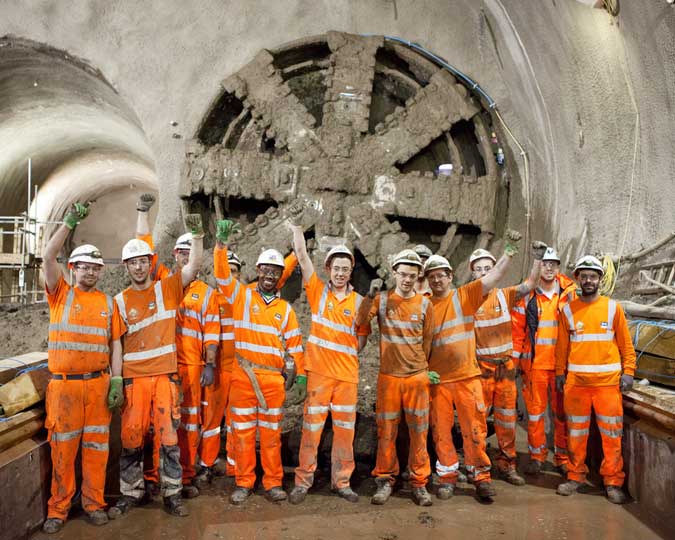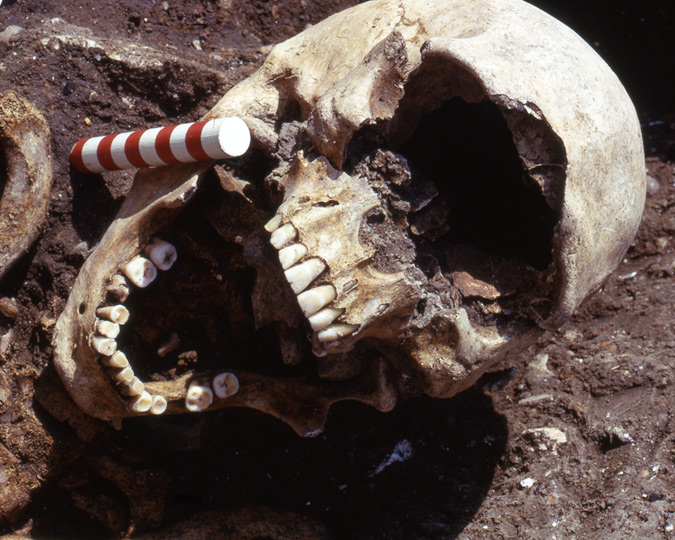In 1988, the remains of thirty-nine Roman Londoners were discovered in the City of London, in what was once the Walbrook valley. Who were they, and how did they die? Dr. Rebecca Redfern reveals the scientific analysis that provides clues to answer an 1800-year-old mystery.
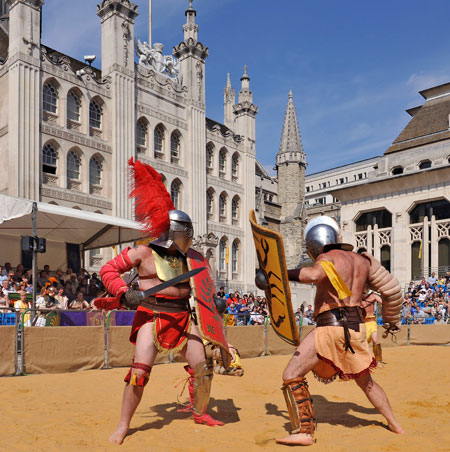
Gladiator Games at the Guildhall
Performers re-enact the glory and gore of the Roman gladiatorial arena outside the Guildhall.
In 1985, developers rebuilding the Guildhall Art Gallery in the centre of the City of London made a startling discovery. They broke through into the remains of a Roman amphitheatre, built when the city of Londinium was the centre of the Roman Empire's rule in Britain.
It was approximately 100 metres long and 85 metres wide, and would have been used for religious activities, animal fights, public executions and on rare occasions, gladiator fights. Today, you can see the outline of the Roman amphitheatre in front of the Guildhall, picked out with a ring of dark stone. The actual remains are about eight metres below the ground, buried under centuries worth of rubble. But this article is about another, somewhat more grisly, archaeological discovery.
Just a few hundred metres away, archaeologists working in 1988 unearthed forty human skeletons, or, more precisely, parts of skeletons. Thirty-nine skulls and one femur (thigh bone) were found, all from different individuals. Technically, we call these disarticulated human remains, where the bones of the body are not in the same positions as they were during the person's life.
The remains were excavated from the upper portion of the Walbrook Valley, inside the Roman city walls, with a stream, the Walbrook itself, running through the site. Roman law and religion banned the burying of bodies inside the city - all of the Roman cemeteries we've excavated have been outside the walls - so what were these people doing here? And, just as importantly, why had they been injured and decapitated? During 2012 and 2013, careful examination of the remains by the museum's Centre for Human Bioarchaeology gave us some fascinating clues.
Firstly, we established the sex of the deceased and their age at death, by studying the shape of the bones and how worn down their teeth were. Thirty-six of the sample were male, and the other four individuals could not easily be established, because the areas of the skull used to determine sex had not survived. All were also relatively young, most between 18 to 35 years old. We know from the evidence of the site where these remains were found that they were deposited in ditches and pits next to the Walbrook between the 1st and 3rd centuries, about 70-200 AD. This was not a period of violence or warfare in Roman London. It came after the Boudican rebellion (60 AD) and reflects a time when Roman London was at its height, with a major programme of public works taking place, including the building of the fort and refurbishment of the amphitheatre.
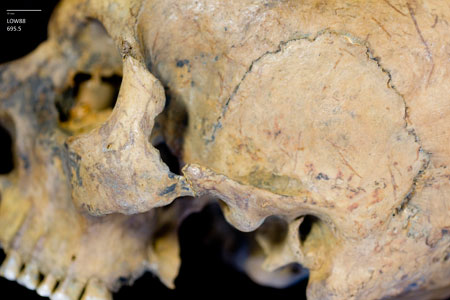
Roman skull with healed fracture of the left cheekbone
Showing that the injury was inflicted some time before death. © Heather Bonney/Museum of London
Different kinds of injuries make different signs on bone, and can give us fascinating information about how these men lived and died.
Ante-mortem traumas are wounds inflicted before someone died, giving the bone time to heal. They tell us about the conditions during the person's life, and how often they had been injured before their death. You can see evidence for these on one of the skulls, where the left cheekbone was fractured some time before death, and the bone has healed back. Many of these individuals had multiple head traumas, ranging from dental damage to signs of skull fractures, suggesting they lived violent lives.
Peri-mortem traumas are wounds sustained at or shortly after death. Most of these 39 skulls had blunt-force traumas sustained at the time of death, and five had sharp-force weapon injuries, which could have been caused by anything from a Roman soldier's sword to a weapon wielded by a gladiator.
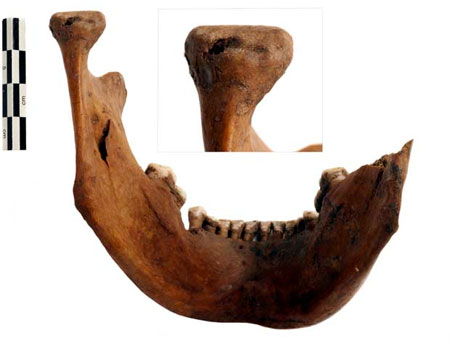
Adult male jaw found in the Walbrook stream
Marks of dog gnawing are evidence that these remains lay in an open pit
The skulls themselves contain further clues. One has signs of being gnawed by a dog, showing that soft tissue was still present when the heads were deposited, and another had the wing-case of a water-beetle lodged in its nasal cavity. Clearly, these remains spent some time lying in an open pit with pools of stagnant water.
Bioarchaeologists at the museum have studied the skeletal remains of hundreds of Roman Londoners. Of all those records, the skulls from this site were the only ones to all be young adult males, and to share these types of injuries and evidence of the fleshed body-parts being left in pits rather than buried.
All of these strands of data, and the lack of written and archaeological evidence for violence in London at this time meant that we had to think of reasons which could account for young men being killed and deposited at this site over several centuries.
Gladiators?

Roman picture lamp
Decorated with a murmillo gladiator in armour. ID no. A22813
Gladiators have become synonymous with amphitheatre games,where heavily or lightly armed combatants would fight other gladiators, animals or prisoners condemned to death. These combatants came from a variety of backgrounds, including the military, the enslaved, criminals and free citizens. They lived and trained in special schools (ludi), many of which were state-owned and fought in amphitheatres across the Empire; usually fighting only two or three times a year.
Evidence suggests that the average age-at-death for gladiators was between 22 and 27 years old. This age range, and the many healed injuries of the Walbrook skulls, would fit with the theory of these men being gladiators who met their deaths in the amphitheatre. The human remains from the only gladiatorial mass grave ever analysed by osteologists (at Ephesus, in Turkey) bore many similarities to the London remains.
Gladiators games were a hugely popular spectator sport, and star fighters could be tremendously famous. Gladiators were Roman celebrities, featured on products like this clay lamp. Despite this, gladiators were considered to be ritually polluted, and were excluded from formal Roman burial grounds. Perhaps this area of the Walbrook valley was used to dispose of people killed in the amphitheatre.
Criminals?
These men could have been criminals condemned to die by the Roman justice system, and bloodily executed, probably in the amphitheatre itself. The manner of death in the arena was variable, depending on their crime (amongst others): hanging, decapitation, crucifixion, death by wild animals, or burning. The evidence from elsewhere in the Roman empire suggests that the majority of victims were adult males, who had suffered extensive injuries before death, and their often disarticulated remains were disposed of in pits outside the walls of the settlements (according to Roman Law), thrown into rivers, or their body was exposed as part of their punishment.
Headhunters?
These men might have suffered an even stranger fate than death in the amphitheatre. The Roman military did decapitate their enemies, and displayed the heads.
The killing of people and the display of their body parts for ritual purposes appear to have taken place in Roman Britain, as human remains have been found in wells, in military forts and outside temples. The Roman military were also strongly associated with headhunting practices, and this practice was depicted on public architecture in Rome, for example on Trajan’s column. The decapitation and display of enemy heads was associated with military valour, and trophy heads were depicted on Roman soldiers' tombstones. Many of the military personnel serving in Londininum would have been stationed at Britannia’s frontiers in the north of Britain, and engaged in sporadic warfare with Britons in Scotland and Northumberland. These battles would have provided them with the opportunity to engage in trophy headhunting. If they were later stationed to the fort in Londinium, they may have carried their grisly trophies south with them.
The fort and amphitheatre give us these two plausible options: trophy heads displayed by the military, or people killed in the arena – gladiators or criminals.
More recent research has given us more clues to who the people buried in Walbrook were. Stable isotope analysis of two of the males found that they were likely to have spent their childhoods in Britain, but a continental origin for one of them cannot be ruled out. We also carried out ancient DNA analysis on one of these males, which revealed that he had brown eyes and dark black hair, and his maternal ancestry matched groups across Europe, North Africa, the Near East and the Caucasus. The analysis discovered that he had peridontal disease, which matched the bioarchaeological evidence for poor dental health.
Want to get updates about the city's buried past straight to your inbox? Sign up for our Archaeology newsletter to find out about upcoming exhibitions, events and articles.








